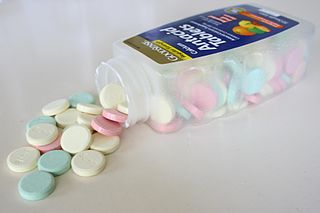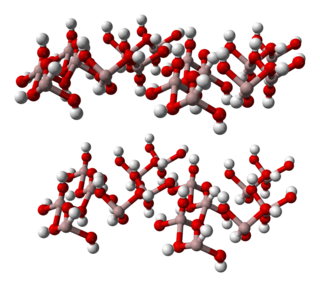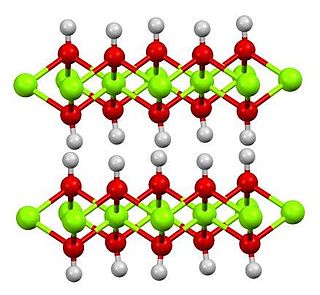
An antacid is a substance which neutralizes stomach acidity and is used to relieve heartburn, indigestion or an upset stomach. Some antacids have been used in the treatment of constipation and diarrhea. Marketed antacids contain salts of aluminum, calcium, magnesium, or sodium. Some preparations contain a combination of two salts, such as magnesium carbonate and aluminum hydroxide.

Aluminium hydroxide, Al(OH)3, is found in nature as the mineral gibbsite (also known as hydrargillite) and its three much rarer polymorphs: bayerite, doyleite, and nordstrandite. Aluminium hydroxide is amphoteric, i.e., it has both basic and acidic properties. Closely related are aluminium oxide hydroxide, AlO(OH), and aluminium oxide or alumina (Al2O3), the latter of which is also amphoteric. These compounds together are the major components of the aluminium ore bauxite.

Magnesium hydroxide is the inorganic compound with the chemical formula Mg(OH)2. It occurs in nature as the mineral brucite. It is a white solid with low solubility in water (Ksp = 5.61×10−12). Magnesium hydroxide is a common component of antacids, such as milk of magnesia.

H2 antagonists, sometimes referred to as H2RAs and also called H2 blockers, are a class of medications that block the action of histamine at the histamine H2 receptors of the parietal cells in the stomach. This decreases the production of stomach acid. H2 antagonists can be used in the treatment of dyspepsia, peptic ulcers and gastroesophageal reflux disease. They have been surpassed by proton pump inhibitors (PPIs); the PPI omeprazole was found to be more effective at both healing and alleviating symptoms of ulcers and reflux oesophagitis than the H2 blockers ranitidine and cimetidine.

Pantoprazole, sold under the brand name Protonix, among others, is a proton pump inhibitor used for the treatment of stomach ulcers, short-term treatment of erosive esophagitis due to gastroesophageal reflux disease (GERD), maintenance of healing of erosive esophagitis, and pathological hypersecretory conditions including Zollinger–Ellison syndrome. It may also be used along with other medications to eliminate Helicobacter pylori. Effectiveness is similar to other proton pump inhibitors (PPIs). It is available by mouth and by injection into a vein.

Famotidine, sold under the brand name Pepcid among others, is a histamine H2 receptor antagonist medication that decreases stomach acid production. It is used to treat peptic ulcer disease, gastroesophageal reflux disease, and Zollinger-Ellison syndrome. It is taken by mouth or by injection into a vein. It begins working within an hour.

Bismuth subsalicylate, sold as generic and under the brand name Pepto-Bismol and BisBacter, is an antacid elixir medication used to treat temporary discomforts of the stomach and gastrointestinal tract, such as nausea, heartburn, indigestion, upset stomach, and diarrhea. It is also commonly known as pink bismuth, but Pepto-Bismol has become a genericized trademark for the substance.

Gastritis is inflammation of the lining of the stomach. It may occur as a short episode or may be of a long duration. There may be no symptoms but, when symptoms are present, the most common is upper abdominal pain. Other possible symptoms include nausea and vomiting, bloating, loss of appetite and heartburn. Complications may include stomach bleeding, stomach ulcers, and stomach tumors. When due to autoimmune problems, low red blood cells due to not enough vitamin B12 may occur, a condition known as pernicious anemia.

Indometacin, also known as indomethacin, is a nonsteroidal anti-inflammatory drug (NSAID) commonly used as a prescription medication to reduce fever, pain, stiffness, and swelling from inflammation. It works by inhibiting the production of prostaglandins, endogenous signaling molecules known to cause these symptoms. It does this by inhibiting cyclooxygenase, an enzyme that catalyzes the production of prostaglandins.

Altana AG is a German chemical company headquartered in Wesel. It was created in 1977 through the spin-off of divisions of the Varta Group. The first CEO was Herbert Quandt.
Roxatidine acetate is a specific and competitive histamine H2 receptor antagonist drug that is used to treat gastric ulcers, Zollinger–Ellison syndrome, erosive esophagitis, gastro-oesophageal reflux disease, and gastritis.
Monocalcium aluminate (CaAl2O4) is one of the series of calcium aluminates. It does occur in nature, although only very rarely, as two polymorphs known as krotite and dmitryivanovite, both from meteorites. It is important in the composition of calcium aluminate cements.
Preoperative fasting is the practice of a surgical patient abstaining from eating or drinking for some time before having an operation. This is intended to prevent stomach contents from getting into the windpipe and lungs while the patient is under general anesthesia. The latest guidelines do not support preoperative fasting, as there is no difference in residual gastric fluid volume, pH or gastric emptying rate following semi-solid meals or drinks, whether in obese or lean individuals.
Lavoltidine (INN, USAN, BAN; previously known as loxtidine, code name AH-23,844) is a highly potent and selective H2 receptor antagonist which was under development by Glaxo Wellcome (now GlaxoSmithKline) as a treatment for gastroesophageal reflux disease but was discontinued due to the discovery that it produced gastric carcinoid tumors in rodents.
Proton pump inhibitors (PPIs) block the gastric hydrogen potassium ATPase (H+/K+ ATPase) and inhibit gastric acid secretion. These drugs have emerged as the treatment of choice for acid-related diseases, including gastroesophageal reflux disease (GERD) and peptic ulcer disease. PPIs also can bind to other types of proton pumps such as those that occur in cancer cells and are finding applications in the reduction of cancer cell acid efflux and reduction of chemotherapy drug resistance.

Tums (stylized as TUMS) is an antacid made of sucrose (sugar) and calcium carbonate (CaCO3) manufactured by GlaxoSmithKline in St. Louis, Missouri, US. They are also available in a sugar-free version. It is an over-the-counter drug, available at many retail stores, including drug stores, grocery stores and mass merchandisers. It provides relief from heartburn and indigestion ("sour stomach").

Aceglutamide, or aceglutamide aluminum, also known as acetylglutamine, is a psychostimulant, nootropic, and antiulcer agent that is marketed in Spain and Japan. It is an acetylated form of the amino acid L-glutamine, the precursor of glutamate in the body and brain. Aceglutamide functions as a prodrug to glutamine with improved potency and stability.
Etomoxir, or 2[6(4-chlorophenoxy)hexyl]oxirane-2-carboxylate, is an irreversible inhibitor of carnitine palmitoyltransferase-1 (CPT-1) on the inner face of the outer mitochondrial membrane. This prevents the formation of acyl carnitines, a step that is necessary for the transport of fatty acyl chains from the cytosol into the intermembrane space of the mitochondria. This step is essential to the production of ATP from fatty acid oxidation. Etomoxir has also been identified as a direct agonist of PPARα. An off-target effect has been demonstrated at high concentrations of etomoxir on Coenzyme-A (CoA) metabolism.

BYK is a globally operating supplier of additives and measuring instruments.
pharma& is an Austrian, Swiss, European pharmaceutical firm than ensures the long-term availability of established original drugs,, distributes most of them worldwide and develops them further. The company pursues a global buy-and-build strategy. The drug Pegasys alone, which was acquired from Roche in 2021, is estimated to generate sales of around 100 million EUR. The purchase price was - according to Roche - CHF 191 million.













